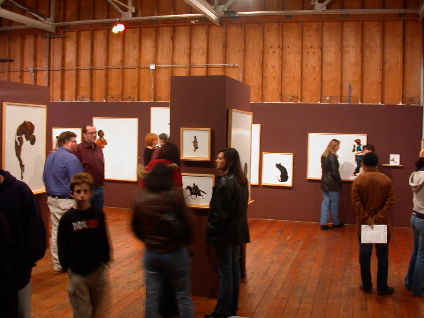|
Titus Kaphar

Titus Kaphar at "Visual Quotations" opening reception

1834- Eugene Delacroix paints Women of Algiers

Visual Quotation, Delacroix 2003, Oil on dry erase white board
VISUAL QUOTATIONS a solo exhibit by Titus Kaphar
Much of black history recorded in Western art is summarized visually by three roles: enslaved, in servitude, or impoverished. But beyond this limited social order lies a people of dignity and strength, whose survival is nothing less than miraculous. "Visual Quotations" investigates that survival.
"Visual Quotations" is a painted adaptation of the portrayal of black people in nineteenth-century Western painting. Though picaninnies and minstrels dominated much of popular imagery in this era, these kinds of overtly brash characterizations were deliberately excluded from this survey in order to observe the more subtle effects of race in painting. A fundamental theme explored in this survey is the implication of hierarchy through compositional positioning (that is, the implication of one's social stature through his or her placement relative to other figures in the composition.)
Within the context of 19th Century paintings most black characters play, at best, secondary roles in the composition. The prototypical image of a black person was as a slave or servant, just outside of illuminated areas of importance. Artists used the dichotomies of the physical world: dark vs. light and up vs. down, to visually reinforce institutionalized views of race and hierarchy.
Throughout the nineteenth- century the representation of hierarchical roles changed very little in painting, but a new context referred to as "the Orient" placed black women in "erotic" and "mysterious" environments. During the late 1800s, the West developed a peculiar preoccupation with the "Orient," and whether consciously or unconsciously, the so-called "Orientalist" painters began to visually address a mythology of black sexuality. This change in the representation of black women creates a sub-text for many of the paintings in this series.
This series is ongoing and at present includes 20 paintings. The original paintings were selected for their relevance within the "canon" of Western art history, and the compositional theme of black and white people portrayed in close proximity. Each piece in this series is painted in oil on dry-erase whiteboards. White figures and all remnants of the original environment are removed from the composition. What remains is the black figure on a white ground in compositional isolation. Through the process of painting, this survey attempts to deconstruct these environmental contexts in order to allow the viewer the visual space to consider the individual represented.
~ Titus Kaphar, 2004

"Visual Quotations" opening reception
|
|
|
Anno Domini presents
Visual Quotations
opens First Friday FEB 6, 2004
8pm 'til late –> free admision
exhibit: February 6 - 26
hours: M-Th Noon - 5 p.m.
additional hours by appointment
call 408.271.5151
map to Anno Domini
Get Together. enlist today
An emerging personal vision
Painter Turns the Tables, Brings Black Subjects Into Foreground
by Jack Fischer, Mercury News
"The paintings are deftly executed and resonate with underlying cultural politics. Done on classroom white board – pertinent both for its color and its intimations of teaching – the paintings depict Blacks pinned like butterflies in a literally white world."
~ Jack Fischer, Mercury News
read the story
Artist shifts viewers' attention
by Paul Richard, The Washington Post
"His acts of isolation give his chosen figures an individuality they didn't have before. The maid holding the flowers in Manet's "Olympia" looks more concerned, and wiser, than we had remembered. So, too, does the sailor in Copley's "Watson and the Shark." In "The Death of Major Peirson" (1783), the soldier with the flintlock is a minor player only, but plucked out of his context he becomes a sort of hero in a fabulous plumed hat."
~ Paul Richard, The Washington Post
read the story
"Visual Quotations" exhibit catalog

Preview the exhibit catalog available beginning the night of the Artist's Reception and online following the Opening of the exhibit. (PDF 3.2mb)
click here
Requires Acrobat Reader 5.0 or higher
download here

"Visual Quotations" opening reception

"Visual Quotations" opening reception

Sidd during installation
|
|